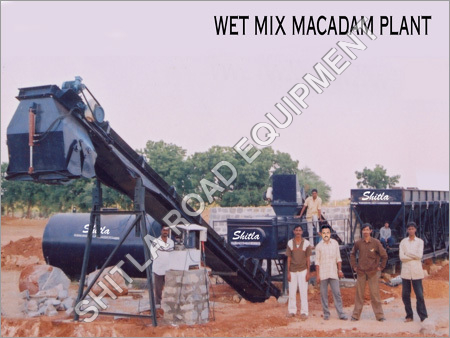
Wet Mix Plant
1500000.00 - 500000.00 INR/Unit
Product Details:
X
Wet Mix Plant Price And Quantity
- 1500000.00 - 500000.00 INR/Unit
- 1 Unit
Wet Mix Plant Trade Information
- Ahmedabad
- Cash in Advance (CID) Cash Advance (CA)
- 4 - 5 Unit Per Month
- 1 Months
- Australia Eastern Europe Western Europe Middle East Africa Central America South America Asia North America
- All India
- ISO
Product Description
We are offering an exclusive range of wet mix plant which are widely used in road building projects. Offered plant is manufactured with superior quality raw material that is procured from the reliable vendors of the industry. Such plants are widely recognized high performance, less maintenance, sturdy construction, corrosion resistance and longer functional life. In order to ensure complete client satisfaction and impeccable performance, this mix plant is stringently tested on various parameters.
Following the modern techniques of production, these plants are installed with twin shaft pug mill which allows higher production at low cost. The Wet Mixing Plant is able to provide a homogeneous mix at high speeds. Offered plants are well-equipped with adjustable gates that can be used to discharge the aggregate into trucks while operating the plant and without any spillage. The Wet Mix Plant can be availed in various capacities from 60 T.P.H to 250 T.P.H as per our clients' requirements.
Standard Configurations of Wet Mix Plant:
1. Pug Mill Unit
2. Four Bin Feeder
3. Slinger conveyor
4. Load out conveyor
5. GOB Hopper
6. Control panel with Cabin
Working Principle of Wet Mix Plant:
A Wet Mix Plant, also known as a Wet Mix Macadam Plant (WMM Plant), is a type of construction equipment used for the preparation of a mixture of aggregates, water, and binding agents such as cement or bitumen to produce wet mix macadam (WMM) base layers for road construction. The working principle of a Wet Mix Plant involves several key components and processes:
1. Aggregates Hopper: The process begins with the loading of various types of aggregates (such as stone chips, gravel, sand, and dust) into a designated storage hopper. These aggregates are typically stored separately and then combined in the desired proportions as per the project specifications.
2. Conveyor System: Conveyors are used to transport the aggregates from the storage hoppers to a central mixing unit. The conveyor system ensures a continuous and controlled flow of aggregates to maintain the required mixture proportions.
3. Mixing Unit: The heart of the Wet Mix Plant is the mixing unit, which consists of a pug mill or a twin-shaft mixer. In this unit, the aggregates from the conveyor system are combined with water and the binding agent (cement or bitumen). The mixing unit thoroughly mixes these components to create a homogenous wet mix.
4. Water Supply System: Water is a crucial component in the wet mix macadam preparation. A water tank and a pump system are used to accurately add water to the mixing unit to achieve the desired moisture content. The amount of water added is controlled to ensure the mixture's workability.
5. Binder Addition (Optional): Depending on the project requirements, a binder such as cement or bitumen may be added to the mixing unit. This binder enhances the cohesion and strength of the wet mix.
6. Discharge Conveyor: After thorough mixing, the wet mix is discharged onto a conveyor belt, which transports it to the spreading equipment or directly to the construction site for laying.
7. Spreading and Compaction: The wet mix is spread evenly on the prepared roadbed using specialized equipment like motor graders or pavers. Once the mix is spread, it is compacted using heavy rollers to achieve the desired density and stability.
8. Curing: If cement is used as a binder, the wet mix layer may need to undergo a curing process to allow the cement to hydrate and harden, further strengthening the base layer.
Benefits of Wet Mix Plant:
Wet Mix Plants offer several benefits in the construction industry, particularly for road and highway projects. These benefits make them a preferred choice for producing wet mix macadam (WMM) base layers. Here are some of the key advantages of using a Wet Mix Plant:
1. High-Quality Base Layer: Wet mix macadam produced by these plants is known for its superior quality. The controlled mixing process ensures uniform distribution of aggregates, water, and binders, resulting in a well-graded and durable base layer.
2. Improved Workability: Wet mix offers better workability compared to dry mixes, making it easier to spread and compact. This facilitates efficient construction and reduces labor and equipment costs.
3. Optimized Moisture Content: Wet mix plants allow precise control over the moisture content of the mixture. This control is essential for achieving the desired compaction and strength characteristics of the base layer.
4. Enhanced Strength and Stability: The use of binders such as cement or bitumen in wet mix improves the cohesion and adhesion of the mixture. This results in a stronger and more stable base layer that can withstand heavy traffic loads.
5. Reduced Dust and Erosion: Wet mix construction minimizes dust generation during the mixing and laying processes. It also reduces the risk of erosion and dust pollution on construction sites and adjacent areas.
6. Faster Construction: Wet mix plants are capable of producing a consistent mixture at a high rate, leading to faster construction progress. This can help save time and reduce project costs.
7. Versatility: Wet mix plants are versatile and can be used for various applications, including road construction, airport runways, parking lots, and industrial pavements. They can adapt to different project requirements by adjusting the mixture composition.
8. Environmental Benefits: The reduced dust and emissions associated with wet mix construction contribute to a more environmentally friendly construction process.
9. Longer Lifespan: The high-quality base layer produced by Wet Mix Plants contributes to the longevity of the road or pavement. It reduces the need for frequent repairs and maintenance.
10. Consistency and Quality Control: Wet mix plants offer better control over the mixing process, ensuring consistency and quality in the final product. This consistency is essential for meeting project specifications and standards.
11. Cost Savings: While the initial setup cost of a Wet Mix Plant may be relatively high, the long-term cost savings can be substantial due to reduced maintenance and repairs on the constructed road or pavement.
FAQ:
Q. What is a Wet Mix Plant?
Ans: A Wet Mix Plant is a construction machine used to prepare wet mix macadam (WMM) for road and pavement construction. It combines aggregates, water, and binders (such as cement or bitumen) to produce a high-quality base layer.
Q. What is the purpose of a Wet Mix Plant?
Ans: The primary purpose of a Wet Mix Plant is to produce a stable and durable base layer for roads, highways, and other construction projects. It ensures proper mixing of materials to create a well-graded and compacted base.
Q. How does a Wet Mix Plant differ from a Hot Mix Plant?
Ans: A Wet Mix Plant is used for preparing WMM, which is a base layer material, while a Hot Mix Plant is used for producing hot mix asphalt (HMA) for the top surface layer of roads. The main difference is in the materials and temperatures involved.
Q. What are the key components of a Wet Mix Plant?
Ans: The main components of a Wet Mix Plant typically include aggregates hoppers, conveyor systems, a mixing unit, water supply system, and optional binder addition equipment.
Q. What types of binders can be used in a Wet Mix Plant?
Ans: Wet mixtures can be prepared with different binders, including cement and bitumen. The choice of binder depends on project specifications and requirements.
Q. How is the moisture content controlled in a Wet Mix Plant?
Ans: Moisture content is controlled by a water supply system that adds water to the mixing unit in precise amounts. This control ensures the mix has the desired moisture level for proper compaction.
Q. What is the significance of compaction in wet mix construction?
Ans: Compaction is essential to achieve the required density and stability of the wet mix base layer. Heavy rollers are used to compact the mixture, ensuring it can withstand traffic loads and provide a stable foundation.
Q. Are Wet Mix Plants environmentally friendly?
Ans: Wet mix construction generates less dust and emissions compared to dry mix processes, making it more environmentally friendly. It helps reduce air pollution and minimizes the risk of soil erosion on construction sites.
Q. Can a Wet Mix Plant be used for different types of projects?
Ans: Yes, Wet Mix Plants are versatile and can be used for various construction applications, including road construction, airport runways, parking lots, and industrial pavements.
Q. What are the benefits of using a Wet Mix Plant for construction?
Ans: The benefits include improved quality, workability, strength, reduced dust, faster construction, versatility, and cost savings in the long run due to reduced maintenance needs.
Q. How can I ensure the proper maintenance of a Wet Mix Plant?
Ans: Regular maintenance, including cleaning, lubrication, and inspection of components, is crucial for the proper functioning of a Wet Mix Plant. Following the manufacturer's guidelines is essential.
Q. What safety precautions should be taken when operating a Wet Mix Plant?
Ans: Operators should follow safety protocols, wear appropriate protective gear, and be trained in operating the equipment safely. Safety measures should also include proper fencing and signage around the plant to prevent unauthorized access.
Our export markets include Africa, Nepal, Bangladesh, Bhutan and UAE.
Get in touch with us



